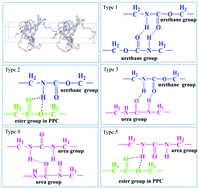A combined experimental and molecular dynamics simulation study of an intrinsic self-healing polyurethane elastomer based on a dynamic non-covalent mechanism†
Abstract
An intrinsic self-healing polyurethane (PU) elastomer with excellent self-healing efficiency was prepared. The self-healing properties of this elastomer as well as the temperature dependence of self-healing can be tailored by regulating the molar ratio of hard to soft segments. The self-healing efficiency of 92.5% is the highest when the molar ratio of 4,4-methylenedicyclohexyl diisocyanate (HMDI) to polypropylene carbonate polyol (PPC) is 1.3 and the temperature is 25 °C. In situ temperature swing infrared spectra and low-field nuclear magnetic resonance reveal that the soft segment, PPC, endows PU with a dense dynamic hydrogen bond network, and the dissociation and reconstruction of the hydrogen bond network enable the PU to heal. To date, the exchange of hydrogen bonds has not been observed intuitively through experimental means. Therefore, the number, type, strength, lifetime, and the exchange of hydrogen bonds in the self-healing process at different temperatures were investigated by molecular dynamics (MD) simulation. The simulated results show that the type of hydrogen bond exchange between functional groups will be affected by temperature. The hydrogen bonds between urethane and urea groups play a leading role in the self-healing properties due to the high strength and a large number of hydrogen bonds at both 25 and 50 °C. The stronger strength, longer lifetime, and greater number of effective hydrogen bonds at 25 °C make the self-healing efficiency of PU higher than at 50 °C.



 Please wait while we load your content...
Please wait while we load your content...